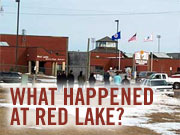April 5, 2005
 |
| Red Lake police officers responded within just a few minutes to the shooting at Red Lake high school last month, entering the school to confront the gunman. That's a change from law enforcement policy in effect at Columbine High School in 1999. (MPR Photo/Dan Gunderson) |
Red Lake, Minn. — (AP) - Less than two minutes after police heard about the shootings at Red Lake High School, well-armed officers stormed inside, headed toward a shootout with the gunman.
Their quick action is credited with saving lives - and it marks a big change in law enforcement tactics since the 1999 Columbine shootings, when police waited outside for about 40 minutes. Critics have said a wounded teacher bled to death during that time.
"Their training kicked in, they covered each other, they checked the doors as they went in," Red Lake Public Safety Director Pat Mills said on Tuesday. "... They responded, utilized their training and went in as a team."
Mills declined to discuss other details of how his officers entered the school, or to say how many went in. He said their response fell somewhere between a meticulously planned entry and a simple headlong rush.
"They had organization to it. They're trained to take care of their safety first," Mills said in an interview with The Associated Press. "They realize that if they don't worry about their own safety, they're no good to anybody."
The officers shot gunman Jeff Weise twice with a .223-caliber gun, forcing him to retreat to a classroom, where he killed himself, according to an e-mail from a sheriff's deputy who said he was given a tour of the school by an FBI agent.
Mills said many of his officers are equipped with M4 carbines, a version of the military M-16 which fires a .223-caliber bullet.
Weise shot to death his grandfather and his companion at their home, then went to the school where he killed a security guard, five students and a teacher before killing himself. Authorities have said the killings at the school took about 10 minutes.
Until the Columbine shootings in 1999, most police departments told their officers to wait outside the school until heavily armed, highly trained officers arrived, said Curtis Lavarello, executive director of the National Association of School Resource Officers. Not anymore.
When "there's knowledge that kids or adults are being killed, we no longer have time to wait for the experts," he said.
"It truly changed the thinking of law enforcement agencies, realizing that everyone on the front lines - the school resource officer, the traffic officer - has to be fully prepared to engage the shooter, to respond immediately," he said.
He acknowledged that a quick response can be more dangerous for police.
"We realize that we may lose officers," he said.
Mills said his officers, who work out of a building almost across the street from the school, practiced a school shooting scenario about two years ago. An actor playing a gunman entered the school, with students present. Officers rushed the building with unloaded guns in hand, using firecrackers to simulate gunfire, Mills said.
Mills said his officers tried to use their training from that drill when the real shooting happened on March 21.
Dispatchers were hampered in calling out the Red Lake police special response team because phone lines were jammed by all the calls coming out of the school, Mills said. Luckily, enough officers were nearby, and they went inside quickly.
"The day it happened, for whatever reason, only the Lord knows, we had adequate staff in the general area," Mills said.
In nearby Beltrami County, dispatchers took some of the first calls from the school, and their sheriff's deputies headed toward the reservation.
"This technique of going after that shooter is becoming more the norm. There's no doubt in my mind that the Red Lake officer probably saved several kids by doing that," Sheriff Keith Winger said.
He said the situation might be different if a lone officer believes he's outnumbered by, say, three gunmen. But he said the Red Lake shooting seems to show that often, waiting is more dangerous for those inside the school.
"I think it has demonstrated that, yes, it's more risky for the officer, but that's the only chance you have for saving victims," he said.
(Copyright 2005 by The Associated Press. All Rights Reserved.)





